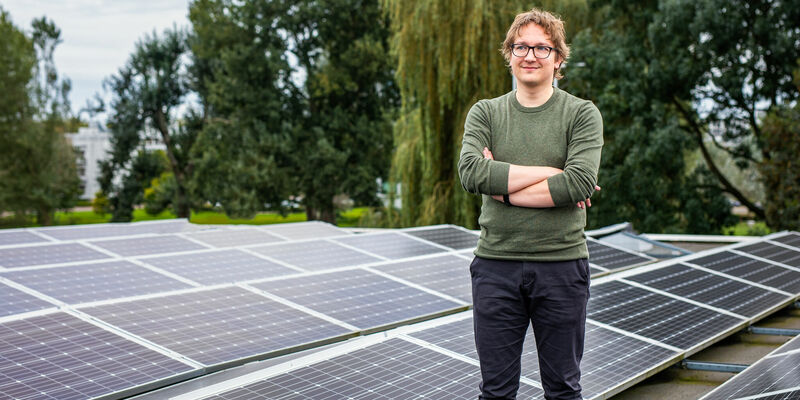
- Research , Home Stretch
- 06/10/2021
Home Stretch | How do we take the load off the electricity grid?
Four years ago when Rik Fonteijn started studying for his doctorate at Electrical Energy Systems he had no inkling of how topical his research subject would become. The need to tap into the flexibility of local generators and consumers to avoid overwhelming the electricity grid was a scenario envisaged in sometime around 2030. In fact, changes to the regulatory framework to enable this option are already being made as a matter of urgency.
In the coming years no more new supermarkets and other large companies will be able to connect to the electricity grid in a large part of the province of North Holland, as Dutch broadcasting organization NOS reported recently. The reason? The electricity grid is ‘full’: the cables and substations are not equipped to deal with the rapid increase in electricity consumption involved in the energy transition.
Similarly, in other parts of the country the electricity grid is at breaking point, knows doctoral candidate Rik Fonteijn. Longer term the solution is simple, he believes: the network must be upgraded. Basically, this means installing new power cables and substations to provide added capacity, but this is a time-consuming process. “You can build a solar park a whole lot faster than power network operators can build their capacity.”
Peak periods
And so, short term, some pushing in the right direction is needed. By way of an example, power network operators such as Enexis, a company with which Fonteijn worked during his doctoral study and which has since hired him as an advisor, can now buy in ‘flexibility’ from market parties. For their part, these parties commit to using less electricity during peak periods or, conversely, to using more at times of surplus supply. “Typically these are wholesalers such as Macro and Sligro. They consume considerable amounts of electricity for cooling purposes, but for a limited period can easily adjust the setting of their refrigeration units up or down, as necessary.” The PhD candidate studied how network operators can make best use of this purchased flexibility.
Let's not forget, explains Fonteijn, that private individuals should also be thinking of how they can make a difference. “Even just switching when you recharge your electric car would help. So not when you get home in the evening but during the night; an app with an automated timer can make this easy. You can do something similar with your washing machine and dishwasher. And now that more and more households are equipped with a heat pump, that also creates options.”
Plenty of research has already been done on this kind of flexibility, says the doctoral candidate. “It is now known that all this is technically possible and that people are receptive to these ideas.” This leads him to believe that thanks to smart technology, private consumers will probably play a future role in preventing the grid from becoming overloaded. And by the time the grid is sufficiently upgraded, they may even be supplying additional power during peak periods - or at times when the power generated by wind or solar energy is low. “After all, in principle, electric cars can also supply power back to the grid.”
Charging points
But what network operators need is assurance, Fonteijn emphasizes. “And so it makes sense to do business with aggregates, as they are known, market parties who can provide a guaranteed supply of the required flexibility.” To investigate how this might work in practice, the doctoral candidate took part in a pilot project that ran until 2019 at Strijp-S, the former Philips industrial site in Eindhoven. Here, a flexible installation was created, consisting of thirteen charging points and a total of 26 connections, a big 315 kWh battery and solar panels with remotely adjustable tilt in order that yield could be adapted to demand.
“At the start of that project no one thought we would have to apply our findings so soon. The need was expected to arise perhaps sometime around 2030; all kinds of restrictive regulations are still in force. But with the current level of urgency, these regulations are now being changed. I don't expect it will be long before the new regulations come into effect.” Fonteijn advises network operators to ‘order’ the flexibility they need a day in advance. Based on experience drawn from the pilot project this seems the most logical timing, because by then the grid authorities have a fairly clear picture of what the electricity grid needs, and the market parties who need to adapt their consumption have the planning window they need.
Power outage
Fonteijn also developed a calculation model for how much the purchased flexibility should cost. “After all, there is a choice to be made. You have the option of not purchasing flexibility and instead overloading the grid temporarily; in principle, the grid can tolerate an overload roughly 30 percent above the normal limit for a couple of hours. This shortens the service life of the electrical components, but you can account for that.” You could even choose to run the risk of a power outage. “You can put a price on that too, and it may even be lower than the cost of purchasing flexibility. It is up to the management of the network operator to decide what they find acceptable.”
For Enexis, his new employer, Fonteijn is currently analyzing his scientific findings. “I wanted to gain my doctorate for work on a practical project, and be sure the findings would not lie forgotten on a shelf. Well, that's certainly been achieved; I expect this will keep me busy for several years to come.”
Discussion